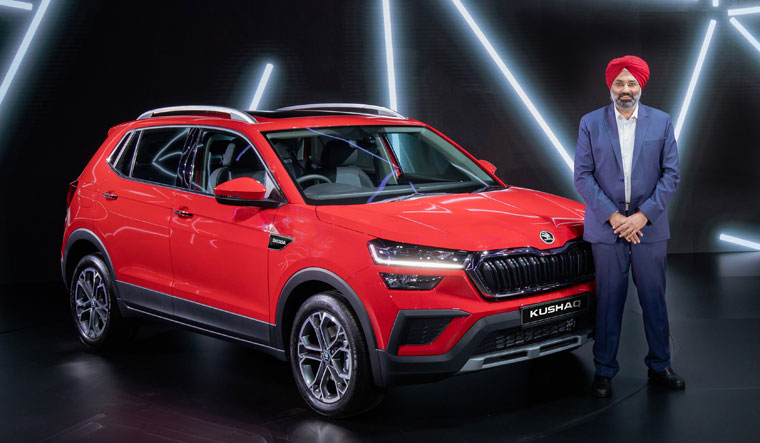Skoda Auto’s new mid-size SUV, Kushaq, made an international debut in India on March 18. Kushaq means king in Sanskrit. Volkswagen AG, Skoda’s parent company, is the world’s second-largest carmaker, but anything but a king in India. The group’s market share is below 2 per cent, despite selling cars in India for two decades. To recharge Indian operations, Volkswagen unveiled the India 2.0 project in 2018, with plans to bring in a brand-new product portfolio built on the localised MQB-A0-IN platform. The group hopes to sell one lakh cars a year by 2025 in India and Kushaq is the first product under this project.
Excerpts from an interview with Gurpratap Boparai, managing director of Skoda Auto Volkswagen India:
Q/ Volkswagen announced the India 2.0 strategy two years ago. How has it panned out?
A/ We kept the India 2.0 project on track despite the disruptions caused by Covid-19. Kushaq has come out on time, as will the next one (Volkswagen Taigun) and the two that will follow later. So, within the next 10-12 months, we will have four products under the India 2.0 plan. Of course, the other premium products will continue side by side and new products will come there also. But, under the 2.0, which is addressing the mass segment, four cars (two SUVs and two sedans) will come out between the two brands in the next 12 months.
Q/ How much is riding on Kushaq to gain the much-needed momentum in India?
A/ We are talking about a 5 per cent market share in India by 2025 and Kushaq will be a big step towards achieving it. This will contribute a lot towards that target. A lot rides for us on this car.
Q/ Are the Kushaq and the other upcoming products going to be India specific?
A/ We will be exporting. Between Skoda and Volkswagen, there will be 30-odd countries where we will be exporting these cars to. Not Europe, but there will be more mature markets than just emerging markets.
Q/ Volkswagen is also launching a product on the same platform. Won’t the products cannibalise each other?
A/ We will announce the prices in June, start bookings and then start deliveries in July. Volkswagen’s product will come three months later. If you have seen the images of the Taigun, it’s quite a different looking car. They will appeal to different sets of customers. Both are very attractive; a little bit of cannibalisation will always happen when you have two products in the same segment. That is natural. But, overall, we won’t have the situation that we have had in the past with the [Volkswagen] Vento and the [Skoda] Rapid being too close to each other. Both [Taigun and Kushaq] are sufficiently differentiated. The interiors are completely different, and the cars look quite different.
Q/ Are SUVs going to be a big driver for Skoda Volkswagen?
A/ It is going to be a key driver for everyone. At the same time, we believe good products in sedans will also still have a place. We believe the segment will grow, as we have seen it grow in the past whenever there was a fresh and exciting product in that segment. And I believe the (upcoming) sedan will be really exciting, too.
Q/ How is your network expansion going to pan out?
A/ We have moved up from 65 dealers to 105, and another 25 will get added by the time this car is launched. So, 130 dealers are what we will be at when this car is launched. That’s a good-sized network, and we will then grow to more than 200 sales touchpoints by 2025.
Q/ Is this new platform suitable for electric vehicles?
A/ Theoretically, you can convert any ICE (internal combustion engine) platform to an EV. As a group, wherever we see volume potential, we have chosen to develop specific EV platforms. But, that doesn’t mean that for India, at least in the short term, we will not look at an ICE engine conversion to EV. We will evaluate it. It (the market) is not yet [ready].
Q/ Skoda’s global chairman Thomas Schafer has talked about more entry-level and value-driven product focus. Will we see this strategy in India as well?
A/ This product is of great value. We can’t go down beyond a certain point. Our standards don’t allow us to go into certain segments.
Q/ So, there are no plans to return to smaller cars or hatchbacks in India?
A/ I am not saying that. But, today we (in India) are limited because hatchbacks are only sub-four metre. The market can evolve. If you go globally, most of the hatchbacks are bigger than four metres. If the taxation here stops favouring sub-four metres, then that body style will also become attractive.
We are not closing our minds to any body style. We will evaluate and then see which one makes more sense for us economically.
Q/ How much potential do you see for India becoming an export base for Skoda and Volkswagen?
A/ Government policies have to support that. A big stumbling block is differential taxation. No one is going to come here and manufacture only to export. You would also want to capture a part of the Indian market. And, frankly, the global share of sub-four metre cars is just about 7 per cent. That’s not where we traditionally operate. So, if we were to make India a manufacturing base for cars that will be going everywhere, they need to also work well for India. And this differential taxation is a stumbling block, not just for us, but for everyone.
The other thing is the lack of FTAs (free trade agreements). Unless we have FTAs with other countries, our exports will always be limited.


